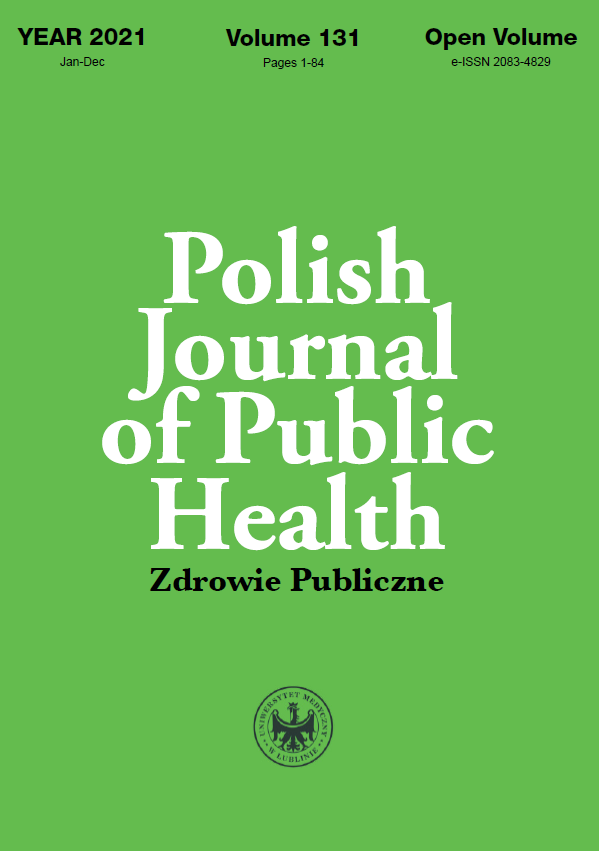Patient safety in the operating theatre
DOI:
https://doi.org/10.2478/pjph-2021-0001Keywords:
patient safety, operating theatre, adverse eventAbstract
In connection with medical services provided, many patients are exposed to harm that may lead to permanent health impairment, hospitalisation, extended hospital stay or even death. Adverse events are reported and are the result of a complex nature of current healthcare systems, in which effective therapy and treatment outcomes of every patient depend on numerous factors, and not only on competencies of individual healthcare professionals.
Individual healthcare professionals can contribute to improving the safety of care by establishing respectful relationships with patients, following procedures, learning from mistakes, and communicating effectively with other members of the therapeutic team. This also decreases costs associated with reduction of harm sustained by patients. Reporting and analysis of errors may help identify major factors that have contributed to their occurrence. In order to consider changes that could prevent errors, at first it is necessary to learn about factors that led to them. An operating theatre is the heart of every hospital. It is where complex and highly specialized surgical procedures are performed in line with state-of-the-art procedures and applicable standards. It is also where employees of various wards meet to perform their crucial tasks that save lives.
Patient’s well-being is a paramount value for a therapeutic team working in the operating theatre. The main goal of surgical nurse is, in turn, to ensure a holistic and individual approach to the patient in accordance with applicable law, procedures and recommendations.
References
1. Zaczyk I. Praca źródłem stresu. [http://www.nursing.com.pl/Medinf_Praca_rdem_stresu_292.html]
2. Weiser TG, Regenbogen SE, Thompson KD, et al. Anestimation of the global volume of surgery: a model ling strategy based on available data. Lancet. 2008;372:139-44.
3. Lisowska B. Ujawnianie zdarzeń niepożądanych. Puls Medycyny. 2005;22.
4. Piątek A. Błędy i wykroczenia w praktyce zawodowej pielęgniarek i położnych a bezpieczeństwo pacjentów. Zdrow. Publiczne. 2005:115(4);465-470.
5. Rozporządzenie Ministra Zdrowia z dnia 11 października 2018 r. zmieniające rozporządzenie w sprawie świadczeń gwarantowanych z zakresu leczenia szpitalnego (Dz. U. z 2018 r., poz. 2012).
6. Motyka M. Empatia a studia pielęgniarskie. Sztuka leczenia. 2006;XIII(1-2):3338.
7. Gwizdak T. Bezpieczeństwo pacjenta w szpitalu. Probl Pielęg. 2008;16(1,2):181-5.
8. Litke J. Lista bezpieczeństwa chirurgicznego – zalecenia Światowej Organizacji Zdrowia. Anestezjol Ratown. 2009;3:254-60.
9. Kryst L. Zdarzenia niepożądane i błędy medyczne w opiece zdrowotnej Bezpieczeństwo Pracy: nauka i praktyka. 2011(11):22-3.
10. Kutaj-Wąsikowska H, Kutryba B. Światowy Sojusz Na Rzecz Bezpieczeństwa Pacjentów, Podstawy wprowadzania okołooperacyjnej karty kontrolnej. Adaptacja na podstawie Implementation Manual Surgical Safety Checklist (First Edition) by World Alliance for Patient Safety. WHO CC Krakow At Centrum Monitorowania w Ochronie Zdrowia. Kraków; 2009.
11. Hanson CW. Procedury w intensywnej terapii. Warszawa: Medmedia; 2009.
12. Kutryba B, Kutaj-Wąsikowska H. Programy bezpieczeństwa. [http://www.mz.gov.pl/wwwmz/index?mr=m7&ms=603&ml=pl&mi=603&mx=0&mt=&my=602&ma=18078.]
13. Kutryba B, Kutaj-Wąsikowska H. Bezpieczny pacjent, bezpieczny szpital [http://www.mz.gov.pl/wwwmz/slajd?mr=m7&ms=603&ml=pl&mi=603 &mx=0&mt=&my=602&ma=018078.]
14. Pokorski J, Pokorska J, Złowodzki M. Błąd medyczny. Uwarunkowania ergonomiczne. Kraków: Polska Akademia Nauk; 2010.
15. Witczak I. Ryzyko występowania „czarnych punktów” w procesach medycznych bloków operacyjnych w Polsce. Public Health Forum. 2017;3(4):256-62.
16. Wróblewska M, Kawecki D. Dezynfekcja skóry i obłożenie pola operacyjnego. Zakażenia. 2008;4:81-6.
17. Definicje zakażeń szpitalnych związanych z opieką zdrowotną (HAI) obowiązujące od 1 stycznia 2016r. Narodowy Program Ochrony Antybiotyków. [http://antybiotyki.edu.pl/definicje-zakazen-zwiazanych-z-opieka-zdrowotna-hai-obowiazujace-od-1-stycznia-2016-r/]
18. Montewka M, Skrzek A, Plewik D, et al. Zakażenia miejsca operowanego – charakterystyka czynników ryzyka, endogennych źródeł zakażenia i metody zapobiegania. Post Mikrobiol. 2012;51(3):227-35.
19. Gospodarek E, Szopiński J, Mikucka A. Zakażenie miejsca operowanego – postaci kliniczne, czynniki ryzyka, profilaktyka, etiologia, diagnostyka. Forum Zakażeń. 2013;4(5):275-82.
20. Ksykiewicz-Dorota A. Zarządzanie w pielęgniarstwie. Lublin: Wydawnictwo Czelej; 2005. p. 454.
Downloads
Published
Issue
Section
License
Copyright (c) 2021 Polish Journal of Public Health

This work is licensed under a Creative Commons Attribution-NonCommercial-NoDerivatives 3.0 Unported License.


